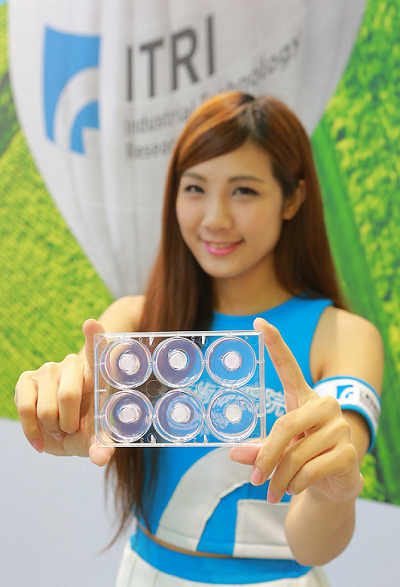Science Fiction
Dictionary
A B C D E F G H I J K L M N O P Q R S T U V W X Y Z
3D Printed Bionic Chinese Skin

A research facility in Taiwan has now developed bionic Chinese skin printed with 3D printing technology.

(3D Printed Bionic Chinese Skin)
Taiwan’s Industrial Technology Research Institute (ITRI)... is the major government-funded institute for Taiwanese technology. ITRI recently presented its 3D printed bionic skin technology at the 2017 BioTaiwan Exhibition.In 2013, the European Union banned animal testing of cosmetics, which got other countries, including Taiwan, considering the ethics of this practice and following suit. But rather than being content to allow for human testing, ITRI developed bionic Chinese skin tissue that could be used to safely test out recipes of new cosmetic materials. 3D printed Caucasian skin wouldn’t do, as its structure and texture differs greatly from Asian skin.
ITRI calls its new bionic epidermal tissue product EPiTRI, which could help cosmetic manufacturers work on material and formula development that stays in line with international regulations and testing guidelines like OECD431 and OECD439. EPiTRI, which has been through strict testing at a multinational laboratory, can be applied in cosmetics for in vitro safety checks. It was derived from Chinese skin cells, and has layers similar to real human skin tissue, including the stratum corneum, followed by a granulosum layer, a stratum spinousum layer, and a basal layer at the bottom.
According to Lai Fengwen, the deputy director of ITRI’s Laser and Additive Manufacturing Technology Center (LAMC), the high-quality EPiTRI bionic skin is 3D printed using active biological tissue while maintaining an ambient temperature of 4°C, in order to maintain biological cell activity and solve the many issues that can crop up while printing with viscous materials.
This bioprinter reminds me of what appears to be a similar device from the 1997 movie Starship Troopers, which is loosely based on the 1959 Robert Heinlein novel of the same name.
(Starship Troopers medical tank)
Via 3D Print.
Scroll down for more stories in the same category. (Story submitted 7/6/2017)
Follow this kind of news @Technovelgy.| Email | RSS | Blog It | Stumble | del.icio.us | Digg | Reddit |
Would
you like to contribute a story tip?
It's easy:
Get the URL of the story, and the related sf author, and add
it here.
Comment/Join discussion ( 0 )
Related News Stories - (" Medical ")
Bone-Building Drug Evenity Approved
'Compounds devised by the biochemists for the rapid building of bone...' - Edmond Hamilton, 1932.
BrainBridge Concept Transplant Of Human Head Proposed
'Briquet’s head seemed to think that to find and attach a new body to her head was as easy as to fit and sew a new dress.' - Alexander Belaev (1925)
Natural Gait With Prosthetic Connected To Nervous System
'The leg was to function, in a way, as a servo-mechanism operated by Larry’s brain...' - Charles Recour, 1949.
Brain Implant Is Able To Capture Your Inner Dialogue
'So you see, you can hide nothing from me.'
Technovelgy (that's tech-novel-gee!) is devoted to the creative science inventions and ideas of sf authors. Look for the Invention Category that interests you, the Glossary, the Invention Timeline, or see what's New.
Science Fiction
Timeline
1600-1899
1900-1939
1940's 1950's
1960's 1970's
1980's 1990's
2000's 2010's
Current News
Golf Ball Test Robot Wears Them Out
"The robot solemnly hit a ball against the wall, picked it up and teed it, hit it again, over and again...'
Boring Company Vegas Loop Like Asimov Said
'There was a wall ahead... It was riddled with holes that were the mouths of tunnels.'
Rigid Metallic Clothing From Science Fiction To You
'...support the interior human structure against Jupiter’s pull.'
Is The Seattle Ultrasonics C-200 A Heinlein Vibroblade?
'It ain't a vibroblade. It's steel. Messy.'
Roborock Saros Z70 Is A Robot Vacuum With An Arm
'Anything larger than a BB shot it picked up and placed in a tray...'
A Beautiful Visualization Of Compact Food
'The German chemists have discovered how to supply the needed elements in compact, undiluted form...'
Bone-Building Drug Evenity Approved
'Compounds devised by the biochemists for the rapid building of bone...'
Secret Kill Switch Found In Yutong Buses
'The car faltered as the external command came to brake...'
Inmotion Electric Unicycle In Combat
'It is about the size and shape of a kitchen stool, gyro-stabilized...'
Grok Scores Best In Psychological Tests
'Try to find out how he ticks...'
PaXini Supersensitive Robot Fingers
'My fingers are not that sensitive...'
Congress Considers Automatic Emergency Braking, One Hundred Years Too Late
'The greatest problem of all was the elimination of the human element of braking together with its inevitable time lag.'
The Desert Ship Sailed In Imagination
'Across the ancient sea floor a dozen tall, blue-sailed Martian sand ships floated, like blue smoke.'
The Zapata Air Scooter Would Be Great In A Science Fiction Story
'Betty's slapdash style.'
Thermostabilized Wet Meat Product (NASA Prototype)
There are no orbiting Michelin stars. Yet.
Could Crystal Batteries Generate Power For Centuries?
'Power could be compressed thus into an inch-square cube of what looked like blue-white ice'
